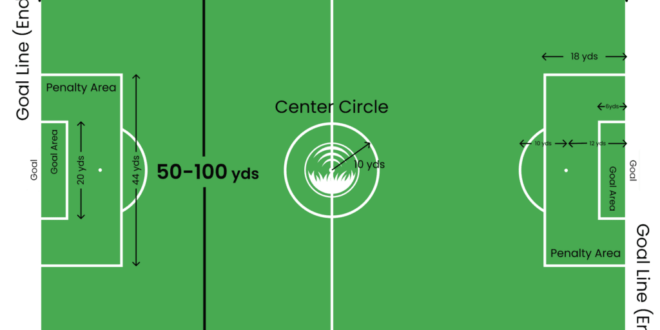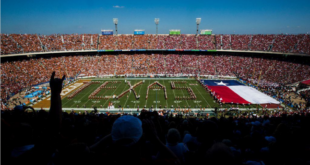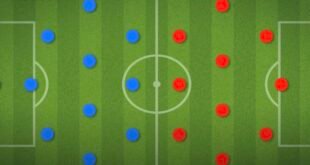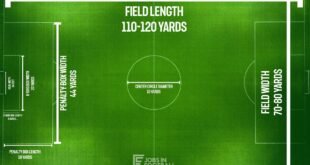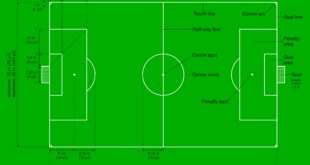A soccer field is typically between 100 and 130 yards long. Its width spans from 50 to 100 yards.
Delving into the world of soccer, or football, as it is known outside the United States, the dimensions of the playing field are crucial to the game’s dynamics. Standard field measurements influence the pace and style of play, setting the stage for this globally beloved sport.
Governed by the International Football Association Board (IFAB), the field dimensions are specified in the Laws of the Game, ensuring consistency across professional matches. Youth, amateur, and pro leagues may adjust these measurements to suit their needs, but they all revolve around the standard range, keeping gameplay fair and exciting. Whether it’s a local youth league or the FIFA World Cup, the size of the field is a foundational aspect of how the game unfolds.
🔴How Many Yards is a Soccer Field🔴
Table of Contents
Soccer Pitch Dimensions
The size of a soccer pitch plays a crucial role in the game. It affects how players pass, move, and score. Knowing the exact measurements can enrich one’s understanding of the game. Let’s explore the standard dimensions set by FIFA and examine how they may vary across different leagues.
Fifa Standard Measurements
FIFA, the international governing body for soccer, has clear guidelines for pitch dimensions. According to their rules, the length of a soccer field must be between 100 and 110 yards. The width has to be within 50 and 100 yards. This standard ensures consistency in professional matches worldwide.
| Area of Pitch | Minimum Size | Maximum Size |
|---|---|---|
| Length | 100 yards | 110 yards |
| Width | 50 yards | 100 yards |
Variations Across Leagues
While FIFA sets strict guidelines, not all leagues follow these exactly. Some may have smaller or larger fields. For instance, fields in younger age leagues or recreational play may not meet FIFA’s minimum dimensions. This flexibility allows for varied playing experiences and tactical differences within different leagues.

Credit: jobsinfootball.com
Length And Width Variation
The dimensions of a soccer field can significantly impact the game, and it is important to recognize that soccer fields, or pitches, are not one-size-fits-all. They often vary in size, which can influence how the game is played. Official matches follow strict guidelines on minimum and maximum sizes, but within those boundaries, there is a range. Understanding this variation is key for players, coaches, and enthusiasts alike.
Minimum And Maximum Sizes
According to FIFA standards, the length of a soccer field should be between 100 yards (90 meters) and 130 yards (120 meters), while the width has a smaller range of between 50 yards (45 meters) and 100 yards (90 meters). Younger players may play on smaller fields to accommodate their age and skill level. Below is a table that summarizes these dimensions:
| Field Type | Minimum Length | Maximum Length | Minimum Width | Maximum Width |
|---|---|---|---|---|
| Adult | 100 yards | 130 yards | 50 yards | 100 yards |
| Youth | Smaller sizes | Varies | Smaller sizes | Varies |
Influence On Playing Style
Soccer field dimensions can change the way the game is played. Smaller pitches often result in quicker plays, emphasizing technical skills and close control. Teams may favor a more direct approach as there is less space to cover. On larger fields, players have more room to maneuver, enabling strategies that involve long passes and wide plays. Coaches often adapt their tactics to exploit the dimensions of the pitch to their advantage. Below are some points explaining this influence:
- Smaller fields may lead to a faster-paced game.
- Larger fields allow for more tactical depth and space exploration.
- Teams must adjust their playing style to suit the pitch size.
- Coaches need a thorough understanding of how space affects gameplay.
Understanding Yardage
Soccer fields vary in size. Official matches need a specific field length. We measure this in yards. Understanding yardage helps grasp soccer’s spatial dynamics.
Yards Versus Meters
Soccer operates with yards globally. Yards and meters differ. One yard equals 0.9144 meters. Countries using the metric system must convert measures.
| Unit | Conversion to Meters |
|---|---|
| 1 Yard | 0.9144 Meters |
Field dimensions in yards easily convert into meters. It ensures accurate field setups everywhere.
Conversion Standards
International standards exist for soccer fields. Lengths between 100 and 130 yards are usual. Widths range from 50 to 100 yards. The common size for many fields is 120 yards long by 75 yards wide.
- To calculate square yards, multiply length by width.
- For meters, use the yard-to-meter conversion then multiply.
These conversions ensure fields meet regulations. They enable precise planning and construction.
Metric Conversion: length(yards) x 0.9144 = length(meters)

Credit: snapsoccer.com
Key Markings On The Field
A soccer field isn’t just a patch of green grass—it’s a canvas with precise markings that guide the flow of the game. Understanding these critical lines and areas helps players, referees, and fans follow the action and the rules that govern it. Let’s explore some of the essential features found on every standard soccer pitch.
Penalty Area And Goals
The penalty area, a vital section of the pitch, demands special attention. Located at each end of the field, this area directly affects gameplay. Features of the penalty area include:
- Dimensions: A rectangle extending 18 yards from the goal line into the field.
- Penalty Mark: A spot 12 yards from the goal, where penalty kicks take place.
- Goal Area: A smaller 6-yard box within the penalty area for goal kicks.
The goals sit on the center of each goal line. Standard goals measure 8 feet high and 24 feet wide. They are the focal point where all players aim to send the ball.
Center Circle And Halfway Line
The center circle and halfway line are vital for restarts and maintaining order at kick-off. Their dimensions are:
- Halfway Line: It divides the field into two equal halves.
- Center Circle: A 10-yard radius circle at the field’s midpoint.
- Center Mark: Directly in the center of the field for starting the game.
All these markings are more than just lines—they’re a language. They communicate the game’s structure, making soccer a sport of precision and strategy.
Regulation Changes Over Time
The size of a soccer field has not always been standard. Over time, the dimensions have evolved. These changes were due to the different needs of players and the game’s development. In this section, we will explore how soccer fields have changed and the effects of these changes.
Historical Differences
In the past, there were no strict rules on field size. Fields varied greatly. Early soccer games saw fields that could be either very small or extremely large. Guidelines eventually set maximum and minimum dimensions.
International matches required fields to be within specific measurements. FIFA standardized this in 1901. Limits were set at 100 to 130 yards in length and 50 to 100 yards in width for international play.
Impact Of Rule Modifications
When FIFA established the current field size regulations, they created a more uniform playing experience. This allowed players to adapt easily to different pitches around the world. Consistency in playing area size benefits both players and officials. Standardized sizes promote fairness in the game.
Field-size regulations affect strategies employed by teams. Smaller fields advantage teams with physical, aggressive playstyles; larger pitches favor teams with good stamina and passing abilities. Those teams can better exploit the spacious playing area.
Rule changes also improved the spectator experience. With defined boundaries, fans have clearer views and better understanding of the game. This leads to increased popularity and enjoyment of the sport.
International Vs. Domestic Fields
Understanding the size of a soccer field is key to appreciating the beautiful game. Soccer pitches vary greatly in size, depending on where and at what level the game is played. ‘International vs. Domestic Fields’ highlights differences between standards set by FIFA and those adapted by domestic leagues around the world.
Regional Field Size Discrepancies
While FIFA dictates a strict range for international match fields, domestic fields often adapt. Regional regulations allow variation, catering to local needs and resources. Field sizes may change due to these factors:
- Stadium constraints
- League preferences
- Training facility limits
Case Studies: Comparing Top Leagues
Examining field sizes in prestigious leagues shows surprising diversity. Let’s look at how some top leagues compare:
| League | Country | Minimum Size (yards) | Maximum Size (yards) |
|---|---|---|---|
| Premier League | UK | 100 | 130 |
| La Liga | Spain | 100 | 130 |
| Bundesliga | Germany | 100 | 130 |
| MLS | USA | 110 | 120 |
Maintenance Of Soccer Fields
Maintaining soccer fields keeps the game safe and fair. Teams play better on well-kept surfaces. It involves careful planning and ongoing care. Let’s delve into the specifics of maintaining the perfect pitch. Correct grass types and precise line marking are the key.
Grass Types And Length
Different grasses suit varied climates. Fields need the right type. Keep grass at the optimum length. It ensures a smooth playing surface. Players perform their best.
- Bermuda Grass: Short and durable for warm climates.
- Kentucky Bluegrass: For cooler regions, mow a bit longer.
- Ryegrass: Quick to establish, but needs more upkeep.
Each type has an ideal length. Soccer fields typically have grass cut between 1 to 3 inches. Consistency across the field is key. It lets the ball roll evenly.
Line Marking Techniques
Crisp lines guide players and officials. They help a match run smoothly. Use marking methods that last. Ensure they stay visible throughout the game.
| Technique | Description | Durability |
|---|---|---|
| Paint Marking | Common and cost-effective. Works on grass of all types. | May need reapplication. Weather-dependent. |
| Laser Guide | Ensures straight lines. Precise and professional. | Permanent fixture. Higher initial cost. |
Remember to check for faded areas. They need touch-ups. Always use non-toxic paints. They’re safe for the environment and players alike.

Credit: en.wikipedia.org
Designing A Soccer Field
A soccer field is more than just a stretch of green turf. It’s a carefully planned area where every yard is essential for the sport’s flow and rules. Designing a soccer field requires meticulous attention to detail and a clear understanding of both regulations and player needs. Whether for local clubs or grand international stadiums, creating the perfect soccer pitch involves strategic planning and execution.
Planning And Resources
Before the first blade of grass takes root, comprehensive planning is vital. It sets the stage for a functional and regulation-compliant field.
- Determine the level of play – amateur, school, professional
- Assess the available space for pitch dimensions
- Choose high-quality turf, either natural or synthetic
- Plan irrigation and drainage systems for field upkeep
- Consider player and spectator amenities
Resource allocation is critical, covering everything from the raw materials to expert consultations. Be ready to invest in quality soil, proper goalposts, and line-marking equipment.
Meeting Regulatory Requirements
A regulation soccer field must adhere to strict dimensions and markings. For international matches, FIFA sets the standard.
| Element | Requirement |
|---|---|
| Field Length | 100 to 110 yards (91 to 100 meters) |
| Field Width | 50 to 100 yards (45 to 91 meters) |
- Ensure adherence to length and width guidelines
- Include distinct, visible markings for the penalty area, goal area, and midfield line
- Align goalposts to field dimensions
- Use recommended turf and provide safety features like corner flags
Regular inspections help maintain these standards. Teams might require a different field size. Know the league rules to design the field accordingly.
Frequently Asked Questions Of How Many Yards Is A Soccer Field
What Is The Standard Yard Size For A Soccer Field?
The standard soccer field is 100 to 130 yards long and 50 to 100 yards wide for international matches. However, variations are allowed based on the competition level.
Can Soccer Field Dimensions Vary?
Yes, soccer field dimensions can vary. Non-professional fields can range widely in size, adhering to minimum standards rather than specific professional regulations.
What’s The Minimum Yard Size For Soccer Fields?
The minimum size for a soccer field is 100 yards in length and 50 yards in width. This sizing is typically for youth or amateur-level soccer.
How Does A Soccer Field Compare To A Football Field?
A soccer field is generally wider and longer than a standard American football field, which measures 120 yards long by 53. 3 yards wide, including end zones.
Conclusion
Understanding the dimensions of a soccer field is essential for players, coaches, and fans alike. Standard fields vary in size, with lengths typically falling between 100 and 130 yards. By familiarizing yourself with these measurements, you enhance your appreciation and strategic grasp of the game, whether you’re analyzing team formations or enjoying a match from the sidelines.
Remember, the field’s size can influence the dynamics of play, making every yard count.
{ “@context”: “https://schema.org”, “@type”: “FAQPage”, “mainEntity”: [ { “@type”: “Question”, “name”: “What is the standard yard size for a soccer field?”, “acceptedAnswer”: { “@type”: “Answer”, “text”: “The standard soccer field is 100 to 130 yards long and 50 to 100 yards wide for international matches. However, variations are allowed based on the competition level.” } } , { “@type”: “Question”, “name”: “Can soccer field dimensions vary?”, “acceptedAnswer”: { “@type”: “Answer”, “text”: “Yes, soccer field dimensions can vary. Non-professional fields can range widely in size, adhering to minimum standards rather than specific professional regulations.” } } , { “@type”: “Question”, “name”: “What’s the minimum yard size for soccer fields?”, “acceptedAnswer”: { “@type”: “Answer”, “text”: “The minimum size for a soccer field is 100 yards in length and 50 yards in width. This sizing is typically for youth or amateur-level soccer.” } } , { “@type”: “Question”, “name”: “How does a soccer field compare to a football field?”, “acceptedAnswer”: { “@type”: “Answer”, “text”: “A soccer field is generally wider and longer than a standard American football field, which measures 120 yards long by 53.3 yards wide, including end zones.” } } ] } Cric Enjoy Sports News, Cricket Update, Live Streaming
Cric Enjoy Sports News, Cricket Update, Live Streaming
